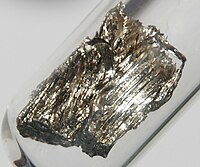
Photo from wikipedia
Jarosite is one of the iron oxyhydroxysulfate minerals that are commonly found in acid mine drainage (AMD) systems. In natural environments, phosphate and sulfate reducing bacteria (SRB) may be coupled… Click to show full abstract
Jarosite is one of the iron oxyhydroxysulfate minerals that are commonly found in acid mine drainage (AMD) systems. In natural environments, phosphate and sulfate reducing bacteria (SRB) may be coupled to jarosite reduction and transformation. In this research, the effect of phosphate on jarosite reduction by SRB and the associated secondary mineral formation was studied using batch experiments. The results indicated that Fe3+ is mainly reduced by biogenic S2- in this experiment. The effect of PO43- on jarosite reduction by SRB involved not only a physico-chemical factor but also a microbial factor. Phosphate is an essential nutrient, which can support the activity of SRB. In the low PO43- treatment, the production of total Fe2+ was found to be slightly larger than that in the zero PO43- treatment. Sorption of PO43- effectively elevated jarosite stability via the formation of inner sphere complexes, which, therefore, inhibited the reductive dissolution of jarosite. At the end of the experiment, the amounts of total Fe2+ accumulation were determined to be 4.54 ± 0.17a mM, 4.66 ± 0.22a mM, 3.91 ± 0.04b mM and 2.51 ± 0.10c mM (p < 0.05) in the zero, low, medium and high PO43- treatments, respectively, following the order of low PO43- treatment > zero PO43- treatment > medium PO43- treatment > high PO43- treatment. PO43- loading modified the transformation pathways for the jarosite mineral, as well. In the zero PO43- treatment, the jarosite diffraction lines disappeared, and mackinawite dominated at the end of the experiment. Compared to PO43--free conditions, vivianite was found to become increasingly important at higher PO43- loading conditions. These findings indicate that PO43- loading can influence the broader biogeochemical functioning of AMD systems by impacting the reactivity and mineralization of jarosite mineral.
Journal Title: Ecotoxicology and environmental safety
Year Published: 2020
Link to full text (if available)
Share on Social Media: Sign Up to like & get
recommendations!